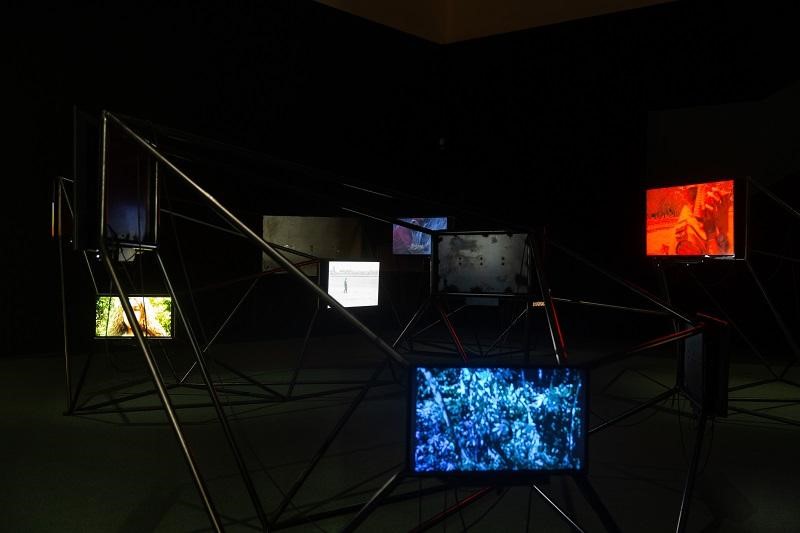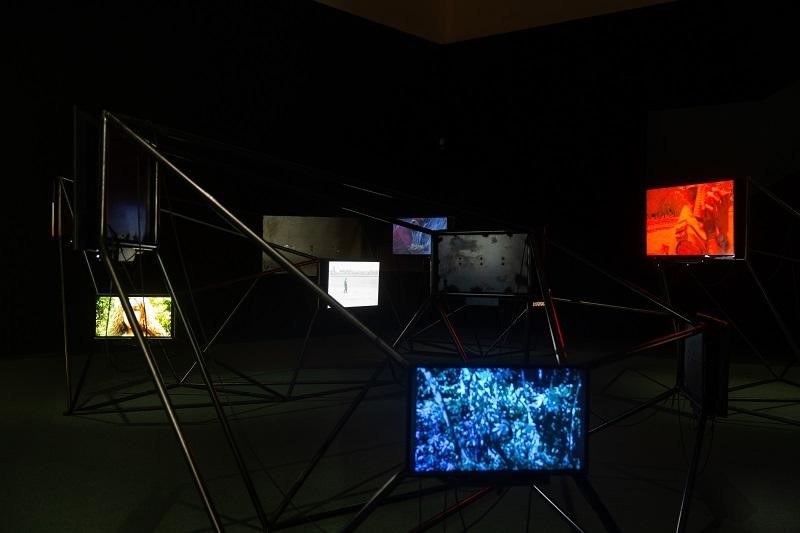
How About Siding with the Object for a Change?
Trans|Cheng Ting Ting
Where is our body when we watch movies in the cinema? What is the body that views a video installation at the museum? How does the connection of “image-installation-viewer” form an ecological network of objects?
Taipei Biennale 2020: You and I Don’t Live on the Same Planet, curated by Bruno Latour and Martin Guinard, transformed Taipei Fine Art Museum into different planets. First, we walked up to the second floor of the museum, where we could see Planet Globalization, Planet Security and Planet Escape, all responding to the various crises that have arisen in the world due to the conceit of anthropocentrism. When we walked down to the first floor, we would land our bodies on Planet Terrestrial, which was Latour’s antidote to the crisis on the second floor. It took us away from the anthropocentric perspective, allowing us to reconsider the world we live in through a non-human perspective. At the same time, it snapped our bodies back into where we were to contemplate how we interact, permeate, resonate and intertwine with non-human species.
A dark room on Planet Terrestrial particularly caught my attention. When I entered the room, I immediately saw a coral reef-like, crystalline metal installation with many screens hanging on each of them. The selected video clips (between 2 to 6 minutes) extracted from 17 different movies were played on the screens. These poetic clips are all related to different species, including humans, animals, plants, minerals, water, fog, ghosts, spirits, etc. The “cold metal device” created an interesting tension with the “poetic video content.” When the audience was attracted to a particular clip and walked closer to the screen, the sensor on the screen would be triggered to play out the clip. The sudden sound from the screens and the ambient noise from the space formed an organic body.

Jean-Michel Frodon and Rasha Salti with COLLECTIVE, Interspecies Cinematic Encounters (2020), installation with screen and sound. (Photo: Taipei Fine Arts Museum)
Interspecies Images Out of the Cinema
The description above is for the work Interspecies Cinematic Encounters, a collaboration of film critic Jean-Michel Frodon, artist Rasha Salti and architectural design team COLLECTIVE. It is noteworthy that the creators here were not presented by a single artist, but as a collective to emphasize the collaborative method. In addition, because both leading artists have a background in curating film festivals, the clips selected were mostly from featured films. In a way, these clips walked “out of the cinema,” and were represented in a museum in an organic way.[1]
The filmmakers of the selected clips did not portray animals or non-human species in a “National Geographic,” eye-catching way. Most of the films were shot in an impersonal perspective, with a sense of detachment and coldness to present the ghost-like images (just like Tropical Malady from Apichatpong Weerasethakul). Unlike the images that emphasize their entertaining value, the film clips chosen were mostly composed of experimental footage or scenery shots without narrative. The remnants of these fragments, which are difficult for us to understand immediately, can also be seen as a resistance to the fleeting images we consume these days. The work further reconstructs our viewing habits from a non-human perspective.
A Concerted Body Summoned by a Video Installation
In contrast to the viewing mode in the traditional cinema, where the viewer sits in a comfortable seat, watching the projection on the screen while their body is forgotten, the design of Interspecies Cinematic Encounters calls on the viewer’s body to participate. The viewer, who was initially gazing at the videos, had to move their body around the space, and use it to “play” the clips. The “viewer” was also transformed from the transcendent position in the traditional cinema to the position of a “Flâneur”[2] who was constantly walking between the crystalline devices. Furthermore, the interactive sensors on the screens transformed the flâneur into an “accompanist.”[3]
And most viewers would not notice the relationship between the sensors and the sounds. They unconsciously co-constructed parts of the overall acoustic field, and contributed to a “polyphony” (composed of wind, water, insects, animals, etc.) with their footsteps. The viewers did not consciously play out these sounds, but unconsciously co-constructed them as an ecological concerto.
How about Siding with the Object for a Change?
In Interspecies Cinematic Encounters, the viewer’s body resisted the predetermined position of the subject (the default position in the traditional cinema) and became the object of the “intermediary,” openly and fluidly intermingling with the non-human species on each screen. This reminds us of Hito Steyerl’s question about the subject: Instead of constantly fighting for the position of the subject, “how about siding with the object for a change? Why not affirm it? Why not be a thing? An object without a subject? A thing among other things?”[4] In short, the work challenged the humanist subject and transformed the viewer’s body into an object, encountering, touching and infecting these non-human images in the dark exhibition space, among the crystalline installation, fragmented footage, and acoustic surroundings, creating a network of interpenetrating relationships with others.
Back to the terrestrial critique of anthropocentrism. On Planet Terrestrial, re-landed with other species, Interspecies Cinematic Encounters offered a non-human perspective, re-evaluating the limitation of anthropocentrism. Unlike the cinema’s disembodied way of viewing, the viewer became the interior of the video configuration in the exhibition.[5] In this work, we left our fixed roles and intermingled with other species, becoming images, objects and non-humans.
However, being objects is not always positive. Under today’s neoliberalism, the objects are often part of an exploitative force (such as social media, shopping websites, streaming platforms). Instead of making us more active, some of the objects are more about controlling us, reducing us to controlled networks of data and relationships.[6] Interspecies Cinematic Encounters worked in the same way. With all the seemingly random sounds and images, it operated within a structure controlled by the artists. We think we were walking freely, but in fact, we were being conditioned and manipulated in specific ways.
An Open Alliance of Objects
In my opinion, the most significant difference between the network of Interspecies Cinematic Encounters and other networks of neoliberalism lies in its “openness.” If we think of neoliberalism as a closed network that homogenizes people into objects that can be controlled and consumed, Interspecies Cinematic Encounters was meant to be an open and unpredictable “heterogeneous object.” It does not reduce people to controllable data entities, on the contrary, it treats people as beings constantly open to the other, continuously connecting and reconfiguring themselves, interacting with animals, insects, minerals, plants, clouds, and so on. In other words, the objects of neoliberalism are calculable data objects, while the network of objects evoked by Interspecies Cinematic Encounters is a landed, organic, dynamic collective alliance that is indissoluble.
Interspecies Cinematic Encounters relocated movies from the cinema to the museum, where the audience is transformed from the spectator to the accompanist (from a closed subject to an open object) through the design of the installation. In the time of Covid-19 pandemic, this galaxy of interspecies images guided us to discover surprises in ordinary things. It invited us to consider the relationship between images, sounds and bodies, and re-imagine the interaction between the artwork and the world. It further led us to reflect on the position and limitations of the subject, and brought the viewer who has forgotten about their body back into the ecological network on the ground.
NOTES
[1] Casetti, Francesco. The Lumière Galaxy: Seven Key Words for the Cinema to Come. Columbia University Press, 2015. P. 19.
[2] Groys, Boris. Art Power. The MIT Press, 2013. P. 64.
[3] It would be limited if we use the term “performer” to describe the role of the viewer in Interspecies Cinematic Encounters, because the performer is still a humanist subject. In fact, the experience with this installation is more like an interspecies synergy, without a main theme or a dominant figure.
[4] Steyerl, Hito. A Thing Like You and Me. e-flux, 2010. https://www.e-flux.com/journal/15/61298/a-thing-like-you-and-me/
[5] The audience becomes a part of the film’s deployment, rather than operating on top of it. Casetti, Francesco. The Lumière Galaxy: Seven Key Words for the Cinema to Come. Columbia University Press, 2015. P. 87.
[6] Foster, Hal. Bad New Days: Art, Criticism, Emergency. Verso Press, 2015. P. 121.
Published in Critical Asia Archives, the gravity of art amid the pandemic issue